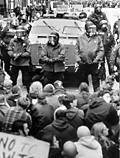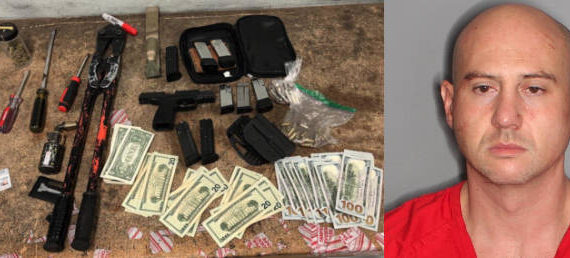FROM UNDERREACTION to overreaction, from protesters’ riot one day to police riot the next, the city flopped about madly in an attempt to contain this week’s World Trade Organization street battles in Seattle.
Despite months of planning, city and conference officials confessed they were unprepared for the costly protest violence and, by inference, that police intelligence had failed them. But police sources say City Hall had the threat analysis information it needed and chose to disregard it, enacting a less dependable, stand-back plan.
“We were tracking the violent groups long before this,” a ranking SPD officer says. “We knew what they could do.” Police Chief Norm Stamper seemed to confirm that this week, admitting at a press conference his department made a “calculated decision” allowing violent protesters to run free.
Tuesday, following a week of WTO heat and months of controversy over his stewardship of the SPD, six-year chief Stamper announced his resignation, effective in March.
Rank and file officers assert it was not a case, as Mayor Paul Schell claimed, of worrying about displaying too much force and sparking confrontations at the Tuesday march. Police should have been deployed strategically to react to spot disturbances, they say. The vandals weren’t difficult to detect: They were the ones with masks, carrying crowbars.
Downtown merchants also say police considered the threat of property violence serious enough that the SPD distributed a memo to businesses weeks ago, urging them to brace for the worst. Merchants were advised to remove storefront items that could cause or lead to damage, plan evacuation routes, and cover windows with plywood.
The city’s decision left merchants indeed boarding up windows Wednesday—after they’d been smashed. By Thursday, the estimated damage and retail sales losses were heading toward $11 million.
In isolated instances, the mayoral-declared state of emergency allowed exhausted, hungry cops (who grabbed catnaps on cots in commandeered courtrooms) the opportunity to lash back at demonstrators who taunted them the day before. Local and network TV video along with eyewitness accounts revealed repeated acts of police brutality, including random pepper-sprayings of bystanders, clubbings, face-printing, and the memorable scene of a gas-masked cop kicking an unresisting Capitol Hill demonstrator in the groin, then shooting him with a rubber bullet. Hill residents already had a testy relationship with police, and the battles provoked further and widening anger in a city wondering why this chaos was necessary.
After all, City Hall’s plan that allowed Tuesday’s free-for-all trashing—followed by a Secret Service demand for a secure city if President Clinton was to attend the WTO trade-talk sessions—spawned Wednesday’s police offensive and provoked further reaction from demonstrators.
An amalgam of city, county, and state officers including the National Guard attacked, gassed, and shot rubber bullets at protesters and others. Anyone inside what the ACLU says is an unconstitutional city no-protest zone was rousted or knocked down, arrested, cuffed, and dragged to buses.
A nondiscriminating police dragnet (most officers hardly identifiable by the numbers on their face shields) rousted or nabbed demonstrators, bystanders, and politicos (County Council member Brian Derdowski was gassed and City Council member Richard McIver was dragged from his car) along with a half-dozen reporters and photographers who were trying to document the violence. Nearly 600 demonstrators and others were hauled away over three days. Businesses were closed or deserted, and at night a martial law-like curfew turned downtown into an eerie no man’s land. Some City Hall reactions were similarly bizarre: In a city where it was still legal to have a handgun, Mayor Schell’s civil-emergency fiat made it illegal to possess a gas mask.
“In hindsight,” assistant police chief Ed Joiner says, “the approach we used [Tuesday] did not work. If we had known what was going to occur, we would have taken a different position in the first place.”
Sources say, however, that police and 30 other local, state, and federal agencies have been aggressively gathering intelligence on violent and nonviolent protest groups since early summer (FBI agents even paid personal visits to some activists’ homes to inquire about their plans). In past weeks, undercover officers have tailed several groups as they moved about the city in cars and vans, and were doing so after the WTO meetings began.
A mostly underground element (the kids in black, some from a Eugene anarchist faction) who trashed downtown were also known to police, officers say, but word from above was to wait and see what happened. “Reactive, not proactive tactics,” says an officer. “We were told not to protect buildings, just set up borders” for the protest march.
Police Chief Norm Stamper says there was “no way” to make arrests Tuesday like the hundreds made Wednesday, due to lack of police numbers. Schell says the city’s strategy was to avoid “arresting a thousand people with a thousand officers” Tuesday, leaving no one to police the demonstration. He argued that the city would have been roundly criticized for suppressing free speech if they had cracked down Tuesday.
But he ordered just such a crackdown Wednesday, and some were asking how the city could have been so unprepared earlier. If the city had put a larger security force on the streets (and along sidewalks) Tuesday, would Wednesday’s offensive have been required?
A close-up eyeballing indicated that at most a few hundred property trashers were responsible for the downtown demolition; arresting even some of them would likely have caused others to back off.
“The mayor and the chief knew the threat was there,” says a police source. “They decided to risk it by forming boundaries and not fanning out even in small forces along the sidewalks” where storefronts were easy targets.
If that smacks of armchair quarterbacking, police and other observers say the truth was always out there—in cyberspace, for one: Chat rooms were busy with threats to, in one chatterer’s words weeks ago, “trash Seattle Tuesday.” It was hard to miss in the mainstream newspapers, as well. As The Seattle Times noted two weeks ago: “Yet to be seen is whether the Seattle conference will trigger riots and criminal mischief, as happened in Geneva and other cities where the WTO has recently met.”
Demonstrators had even made their plans known at training camps last month and at a press conference Monday, November 29, detailing a strategy to fan out during the march and close down the city.
On MSNBC last week, former head-banging LA police chief Daryl Gates defended police reactions (watching a Seattle cop-protester confrontation on video, he interjected: “If I were a police officer, that guy would have a broken rib by now!”). But Neil Livingston, a crisis management expert, said Seattle cops lost control of the situation: “I sympathize with the rank and file police officers there. I think they were betrayed by the city officials and their own top echelon officers who planned this thing.”
City Hall’s miscues left Mayor Schell apologizing to WTO delegates, saying “The last thing I ever wanted to be was the mayor of a city where I had to call out the National Guard.”
But a ranking SPD officer says the guard wasn’t even really needed. “We could have done the job,” he insists. “We just had the wrong game plan.”








